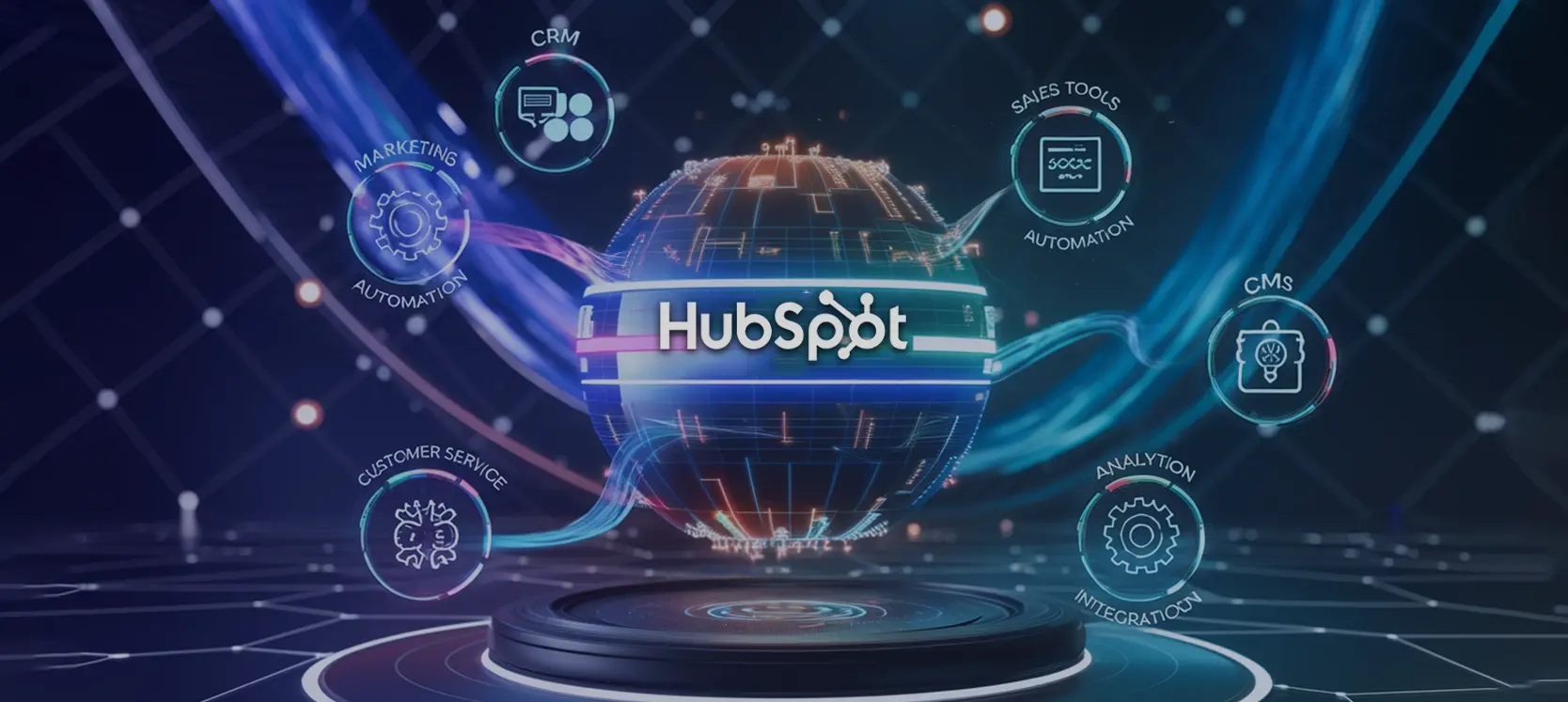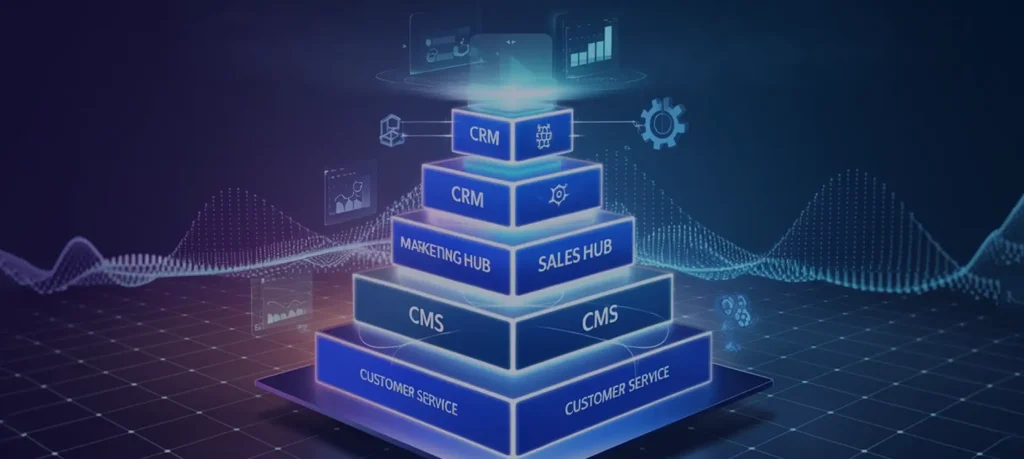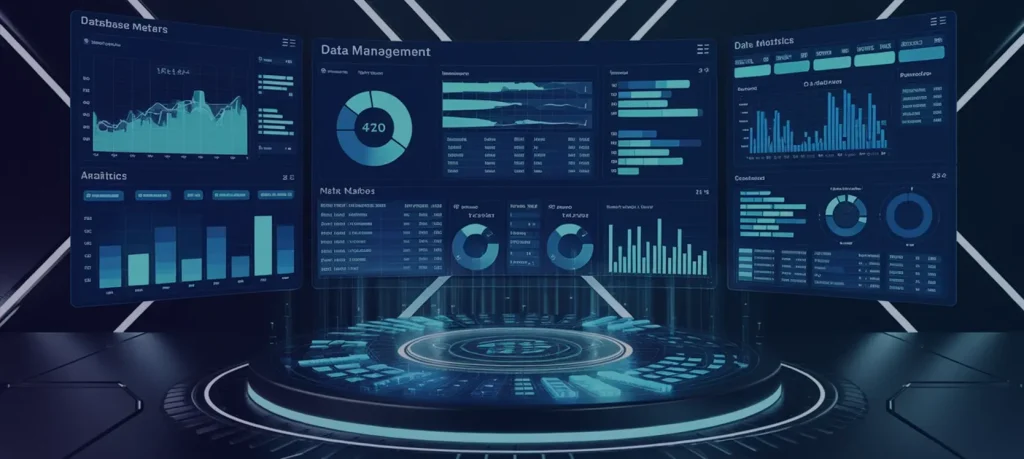
What does HubSpot Tech Stack Consist Of: A Detailed Guide
22 Jan 2025Introduction
Curious about what makes HubSpot tick? The HubSpot tech stack powers the whole marketing automation platform. Do you know more than 238,000 companies using HubSpot to scale? Therefore, most marketing and sales professionals cannot deny the power capabilities it has to offer.
This guide will primarily discuss the HubSpot tech stack essentials its cloud infrastructure, programming languages, databases, APIs, and their roles in its development. Let’s begin, shall we?
What is a HubSpot tech stack?

“The reason why I use Hubspot is because it's all-in-one platform: CRM, email newsletter, sign up forms, social media management, email automations etc.”
Reddit answer,
Understanding the technology and inner workings of the HubSpot marketing hub is crucial for maximizing the platform’s potential. This is where the concept of a “tech stack” steps in.
A “tech stack” refers to the combination of technologies a company uses to build and run its applications. It includes programming languages, frameworks, databases, servers, and other tools. Knowing the HubSpot tech stack provides insights into its performance, scalability, and security.
It also helps marketers and team leaders understand how HubSpot integrates with other systems.
The Foundation: Cloud Infrastructure and Hosting
More than 94% of enterprises already use a cloud strategy, and HubSpot is firmly rooted in this technology. Cloud computing means HubSpot isn’t software you install on your computer. Instead, it lives on powerful servers accessible through the internet.
It means you can access HubSpot from anywhere with an internet connection. No more being tied to a specific office computer. Second, HubSpot handles all the technical heavy lifting, like server maintenance, security updates, and data backups.
As your business expands, the infrastructure can adapt accordingly. This cloud-based architecture is the spine of the HubSpot tech stack, giving accessibility, reliability, and scalability for all enterprise-sizes
HubSpot’s Use of Amazon Web Services (AWS)
HubSpot’s platform, and therefore your data, resides within AWS’s secure and robust infrastructure. AWS provides HubSpot with a vast array of services, from computing power (like virtual servers) to storage solutions (for storing your data) and networking capabilities.
By utilizing AWS as of the HubSpot tech stack, the platform is consistently accessible to users around the globe. AWS adds a layer of scalability for increasing data volumes and user traffic. This partnership allows the AI-powered platform to focus on developing its core software while relying on AWS for the underlying infrastructure. HubSpot uses Amazon EC2 for its scalable computing capacity, Amazon S3 for its object storage, and Amazon RDS for its managed relational database service.
HubSpot Data Centers and Global Reach
I shall consider an example: a network of digital fortresses, strategically scattered around the world. This isn’t a spy movie scene, but rather the reality of HubSpot’s data center strategy. HubSpot has geographically distributed data centers, unlike software tethered to a single location.
The benefit? Breakneck speed and unwavering availability for you, no matter where you are. If a user in London needs to access HubSpot, they’re directed to the closest data center. This global network also provides redundancy. If one data center faces an issue, others can pick up the slack, preventing downtime and giving continuous access to HubSpot’s features.
The data center strategy isn’t just about location; it’s about guaranteeing performance and reliability for worldwide users.
Core Programming Languages and Frameworks
Python consistently ranks among the most popular programming languages globally, and it plays a vital role in HubSpot’s backend. Python is known for its readability, versatility, and extensive libraries, making it “THE” tool for building complex web applications.
On the front end, where you interact with the HubSpot interface, JavaScript is the dominant language. Paired with modern JavaScript frameworks like React, JavaScript enables the dynamic and interactive elements you see in HubSpot’s user interface.
While other technologies are likely involved, Python and JavaScript form the core of HubSpot’s development landscape, enabling both robust backend functionality and a user-friendly front-end experience.
Python’s Role in HubSpot’s Backend
What if HubSpot was a giant iceberg? The user interface you see and interact with is just the tip, but beneath the surface lies a complex world of data processing and logic. This hidden world relies heavily on Python. I also mentioned above how Python is a solid coding language known for its clarity and efficiency.
Python takes incoming requests, retrieves database information, and executes complex calculations.
It might be crunching website traffic data to understand visitor behavior or personalizing email campaigns for maximum impact. Python’s magic lies in its ability to tackle these tasks without any hassle. Just like a chef meticulously prepares fresh ingredients, Python checks that all the data HubSpot uses is clean, organized, and ready for analysis. So, while you might be interacting with HubSpot’s user-friendly interface, Python is quietly working behind the scenes, making it all possible.
JavaScript and Frontend Development
Did you know that 97% of all websites use JavaScript in some way? It’s the web’s workhorse, and HubSpot uses it extensively to craft the user interface (UI) and interactive elements you experience daily. The HubSpot interface is like a bustling urbanscape.
JavaScript acts like the traffic signals, buttons, and dynamic displays that bring the city to life. It controls how elements appear on your screen, how they respond to your clicks, and how data is presented interactively.
To create this dynamic experience, HubSpot utilizes JavaScript frameworks like React or Angular.
These frameworks provide pre-built tools and structures, allowing developers to work on functionality instead of reinventing the wheel. HubSpot can create a visually attractive and responsive UI experience with JavaScript and its frameworks.
Other Languages and Technologies
HubSpot’s tech stack isn’t a one-trick pony. While Python and JavaScript take center stage, other technologies play supporting roles in building a well-rounded platform.
For instance, databases are the filing cabinets of the digital world, and HubSpot likely uses a combination of technologies here. MySQL, a popular relational database, might store structured data like contact information or marketing campaign details.
NoSQL databases could also be in the mix.Traces of Java or Ruby on Rails might be found from HubSpot’s earlier days, but these likely play a diminishing role as the platform evolves. The key takeaway is that HubSpot’s tech stack is a well-coordinated team, with each technology bringing its strengths.
Databases and Data Management

Imagine the sheer volume of data HubSpot handles: millions of contacts, countless marketing campaigns, and a constant stream of user interactions. Managing this digital ocean requires a robust and well-organized system. HubSpot relies on a combination of database technologies.
“Workflows and automation ensure customer data isn't just stored but actively used to drive personalized experiences.”
For structured data, like contact details, deal information, and product catalogs, HubSpot likely uses relational databases, perhaps MySQL. These databases organize data into tables with clear relationships, making it easy to search, sort, and retrieve specific information. But what about unstructured data like website logs, user behavior, or social media interactions? Here, NoSQL databases could come into play.
MySQL for Relational Data
70% of businesses rely on relational databases for their core data storage. HubSpot is no exception. For all the fancy marketing automation and social media integrations, the foundation lies in a potent workhorse: a relational database, likely MySQL or a similar technology.
A relational database is like an organized filing cabinet. It meticulously looks after HubSpot’s structured data. Contact information, deals in various stages, and marketing campaign details – all this critical information is stored in a structured format within the database.
Each data point has its own designated place, with clear relationships defined between them. This structured method allows HubSpot to perform lightning-fast searches and retrievals. Need to find a specific contact’s email address for a targeted campaign? The database can pinpoint it instantly.
NoSQL Databases for Scalability
The digital world is also full of unstructured information: website logs, social media interactions, and streams of user activity. This is where NoSQL databases like MongoDB or Cassandra shine. These are versatile storage units of the data world. They don’t force data into rigid tables but rather allow for more flexible storage formats, making them great for managing bulks of information.
In HubSpot’s case, NoSQL databases could store and analyze website traffic data, understand user behavior on the platform, or manage real-time interactions like live chat conversations. These databases also have high scalability. As HubSpot’s user base and data volume grow, NoSQL databases are like an adaptable storage solution that can expand as needed, HubSpot can handle the ever-growing ocean of data.
Data Warehousing and Analytics
Wait, there’s still a lot more that I have to share about the HubSpot tech stack. HubSpot’s data warehousing system gathers data from various sources within the platform – marketing campaigns, sales interactions, customer service tickets – and stores it in a central repository. This data is then refined, making it ready for analysis.
HubSpot likely uses technologies like ETL (Extract, Transform, Load) processes to move data from operational databases to the data warehouse. This often involves cleaning, transforming, and structuring the data for querying. Once the data is in the warehouse, analytics tools come into play. These tools allow HubSpot and its users to generate reports, and predict future trends.
HubSpot APIs and Integrations
APIs (Application Programming Interfaces) are the secret handshake of the software world. They’re what enables different applications to talk to each other and exchange information. In HubSpot’s case, APIs extend its functionality beyond its main features.
Without APIs, HubSpot would be an isolated island. With them, it becomes part of a thriving ecosystem. For example, you might want to connect your e-commerce platform to HubSpot to track customer purchases and personalize marketing campaigns. This is where APIs come in.
HubSpot’s REST APIs
“REST stands for Representational State Transfer. This means that when a client requests a resource using a REST API, the server transfers back the current state of the resource in a standardized representation.``
REST APIs operate using simple requests and responses over the internet. A program sends a request to HubSpot’s server, specifying what data it needs or what action it wants to perform. HubSpot’s server then responds with the requested data or confirmation of the action. This straightforwardness makes integrations easier to build and maintain.
App Marketplace and Partner Ecosystem
It’s a curated collection of HubSpot integrations built by independent developers and software companies, expanding the customer relationship management platform’s capabilities. It is indeed an extension of HubSpot’s toolset, offering custom tech solutions.
This marketplace operates thanks to HubSpot’s open API. This API acts as an invitation for developers to forge connections between their software and HubSpot. They can make integrations that sync data, automate workflows, or add entirely new functionalities to HubSpot. This means you can find apps for everything from e-commerce integration and social media management to advanced analytics and project management.
The App Marketplace benefits both HubSpot users and developers. The best is that users get access to a wider range of tools, tailored to specific requirements.
Security and Compliance

HubSpot prioritizes the protection of its data and that of its customers through a robust, multi-faceted security strategy. Safeguarding sensitive data requires constant vigilance. Data security is a top priority at HubSpot.
“The availability of sensitive data storage in HubSpot is not limited to a single platform. It is accessible across various HubSpot enterprise platforms, including the Enterprise Customer Platform, Marketing Hub Enterprise, Sales Hub Enterprise…”
Maximizing Security: Sensitive Data Storage in HubSpot, Frank Mutel
In this section, I will talk about these features in detail. From encryption and access controls to compliance with industry standards, there’s the involvement of multiple aspects.
Data Encryption and Security Protocols
Data encryption is a key element. HubSpot uses encryption both when data is moving between your browser and their servers (in transit) and when it’s stored on their systems (at rest). This scrambling of data makes it unreadable to unauthorized parties, like a secret code.
They also implement strict access controls. This means only authorized personnel have access to sensitive data, and even then, their access is limited based on their role. This prevents internal misuse or accidental exposure.
Regular security audits and penetration testing are also part of their strategy.
Compliance Certifications (e.g., ISO 27001, SOC 2)
Certifications act like a stamp of approval, showing a company’s commitment to meeting rigorous security standards. HubSpot understands this and invests in achieving and maintaining key compliance certifications. So, if you’re asking, “Is HubSpot secure?” or “What security certifications does HubSpot have?”, here’s what you need to know:
HubSpot holds several important certifications that demonstrate its dedication to preserving data. You’ll often hear about ISO 27001, which is a globally recognized standard for information security management systems. This shows HubSpot has a systematic philosophy when we talk about sensitive company information. Another key certification is SOC 2 (System and Organization Controls 2).
Development and Deployment Processes
Alas! Here comes the last part of this article. However, it’s equally important. HubSpot’s software isn’t static; it’s constantly evolving with new features, improvements, and bug fixes. The updates HubSpot releases generally follow an agile development methodology.
Once a feature is developed, it goes through rigorous testing to catch any potential issues before it reaches users. This involves various types of testing, from unit tests (testing individual components) to integration tests (testing how different parts of the system work together).
For deployment, HubSpot likely uses Continuous Integration and Continuous Deployment (CI/CD) practices. This means that code changes are frequently integrated and automatically deployed to production environments.
Agile Development Methodologies
Instead of following a rigid, linear plan, agile breaks down projects into smaller chunks called “sprints.” These sprints are short development cycles, typically lasting a few weeks.
“HubSpot embraced the fluidity of “sprints” intense bursts of focused effort aimed at specific marketing objectives. Cross-functional teams, united in purpose, worked in harmonious sync. Daily stand-ups became the heartbeat of their collaboration..”
HubSpot: From Waterfall to Whitewater – Conquering Marketing with Agile
Within each sprint, a small, cross-functional team works together to design, develop, test, and deliver a specific set of features or improvements. This iterative approach allows for frequent feedback and adjustments along the way. If something isn’t working as expected, the team can quickly pivot and make changes.
Continuous Integration and Continuous Deployment (CI/CD)
CI/CD, which stands for Continuous Integration and Continuous Deployment, is a cornerstone of how HubSpot growth hub delivers updates to its platform.
Continuous Integration (CI) is like having developers constantly merge their code changes into a central repository. This happens multiple times a day, not just in large, infrequent batches. Each merge triggers automated tests to quickly catch any conflicts or bugs. This prevents integration headaches and keeps the codebase stable.
Continuous Deployment (CD) then takes over, automating the release process. Once code changes pass all the tests, they’re automatically deployed to the live HubSpot platform. The rapid release cycle keeps HubSpot current, responsive to user feedback, and ahead of the curve in a fast-paced digital world.
Conclusion
Time to sum things up! HubSpot marketing suite relies on a sophisticated tech stack. First and foremost, it relies on cloud infrastructure from AWS for reliability and scalability.
Python drives the backend logic and data processing, while JavaScript and frameworks like React create the interactive user interface. Databases, likely including MySQL and NoSQL solutions supervise so much data.
RESTful APIs lead to seamless integrations with other tools, expanding HubSpot’s functionality. Understanding this underlying technology not only tells us about the technical details but also breaks down the architecture of HubSpot. In the future, we can anticipate HubSpot adopting new advancements in areas like AI, machine learning, and serverless computing!
FAQS
What are the components of HubSpot CRM?
HubSpot CRM is structured around core components that organize and keep a check on customer interactions.
At its heart are four key “objects”: Contacts, which store individual people’s information; Companies, which house details about the businesses associated with those contacts; Deals, used to track sales opportunities and manage the sales pipeline; and Tickets, for managing customer support requests.
Which company is bigger Salesforce or HubSpot?
Salesforce is the bigger company by a considerable margin. This isn’t to say one is inherently better than the other.
They cater to different needs and business sizes. But in terms of sheer size and market presence, Salesforce is the larger player.
What is the meaning of a HubSpot tech stack?
The HubSpot tech stack refers to the collection of technologies HubSpot uses to build and run its software platform.
It’s essentially the behind-the-scenes toolkit that makes HubSpot work. It includes programming languages, APIs, security details, databases and cloud infrastructure
Does HubSpot marketing hub have a knowledge base?
Yes, HubSpot has a comprehensive knowledge base!
It’s a vast library of articles, tutorials, and documentation covering all aspects of the HubSpot platform, including the Marketing Hub.
It can become your go-to resource for any questions you might have about using HubSpot. You can find information on everything from setting up email campaigns and creating landing pages to analyzing your marketing data and integrating it with other tools.
What is the HubSpot controversy?
HubSpot reported a security incident where unauthorized access was gained to a small number of customer accounts.
While the impact was limited, it raised concerns about data security.
You never to consider the company’s overall track record and its ongoing efforts to improve its culture, security, and communication.


